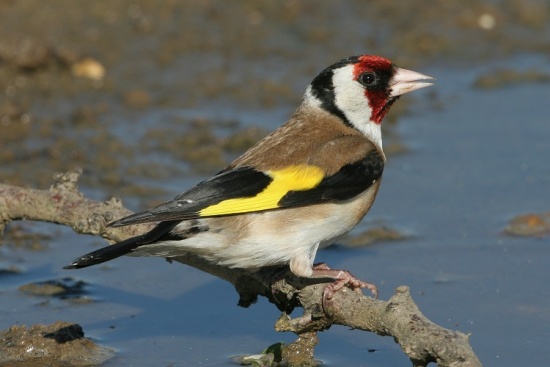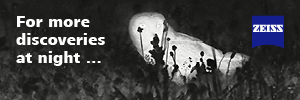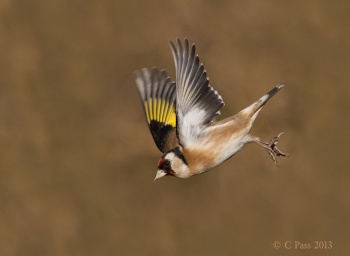
- Carduelis carduelis
Identification
L. 12-13 cm
W. 21-25 cm
Weight of 14 to 19 grams
- Red face
- Black and white head
- Warm brown upperparts
- White underparts with buff flanks and breast patches
- Black and yellow wings.
- Ivory bill
- Forked tail
Sexes similar but male has a larger red mask reaching just beyond the eye in some individuals. The feathers covering the top of the beak are generally black or dark brown in males and light tan to white in females and this holds true for juveniles and adults. Some individuals are intermediate and difficult to sex in the field.
Juveniles
- Plain head
- Greyer back
- Unmistakable due to the yellow wing stripe
Variation
Subspecies caniceps has a red face but otherwise a plain grey head.
Distribution
Breeds throughout Europe, north Africa, and Asia. Mainly resident, but migrates from colder regions.
Introduced to South America. Australia, New Zealand, and USA (Wisconsin, Illinois, and New York).
Taxonomy
Subspecies
There are 12 subspecies[1]:
- C. c. britannica: British Isles, Channel Islands, northwestern France to western Netherlands
- C. c. carduelis: breeds southern Scandinavian Peninsula east to central Urals, south to eastern Netherlands, central France, Italy, northwestern Romania, Moldova, and northern Ukraine; partially migratory, wintering from central and southern Europe east to western Kazakhstan
- C. c. parva: Azores, Madeira, Canary Islands and western Mediterranean region
- C. c. tschusii: Corsica, Sardinia and Sicily
- C. c. balcanica: Southern Yugoslavia to Bulgaria, Greece and Crete
- C. c. niediecki: Rhodes, Karpathos, Cyprus; Egypt to Asia Minor, northern Iraq, south-western Iran
- C. c. brevirostris: eastern Turkey east to northern Iran
- C. c. colchica: Crimean Peninsula to Caucasus and northeast Turkey
- C. c. volgensis: southern Ukraine, southeastern European Russia, and extreme northwestern Kazakhstan
- C. c. major: South-western Siberia (Ural Mountains to Yenisey River)
- C. c. paropanisi: Iran to northern Afghanistan and western China (Xinjiang)
- C. c. subulata: South-central Siberia to Lake Baikal and north-western Mongolia
- C. c. caniceps: Western Himalayas (Kashmir to Nepal and western Tibet)
- C. c. ultima: southern Iran
Habitat
Weedy fields, gardens.
Behaviour
Can form large single species winter flocks, or be found flocking with other finches.
Diet
The main diet consists of seeds, particularly from thistles and teasels, insects are fed to the young. A regular visitor to garden bird feeders.
Breeding
The nest is placed in the fork of a small tree or bush. It is made from dead grass, rootlets, thistledown, wool and cobwebs. The clutch consists of 5 bluish-white eggs which are covered in grey and brown spots. Incubation lasts about 2 weeks, the young fledging after a further 2 weeks.
There may be up to 3 broods in a season which runs from April to September.
Vocalisation
References
- Clements, J. F., T. S. Schulenberg, M. J. Iliff, T. A. Fredericks, J. A. Gerbracht, D. Lepage, S. M. Billerman, B. L. Sullivan, and C. L. Wood. 2022. The eBird/Clements checklist of Birds of the World: v2022. Downloaded from https://www.birds.cornell.edu/clementschecklist/download/
- Wikipedia
- Bird Watching
Recommended Citation
- BirdForum Opus contributors. (2024) European Goldfinch. In: BirdForum, the forum for wild birds and birding. Retrieved 26 April 2024 from https://www.birdforum.net/opus/European_Goldfinch
External Links
GSearch checked for 2020 platform.1





